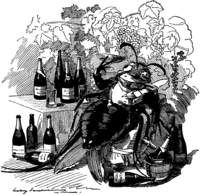
Photo from wikipedia
Image transmission over Low-Power Wide Area Networks (LP-WAN) protocols has always been a difficult task since it necessitates high data rates and high energy consumption. Long Range (LoRa) is one… Click to show full abstract
Image transmission over Low-Power Wide Area Networks (LP-WAN) protocols has always been a difficult task since it necessitates high data rates and high energy consumption. Long Range (LoRa) is one such protocol, which is excellent for transferring data over long distances but has generated severe doubts regarding the viability of image transmission due to its low data rate. This paper demonstrates the application results of an integrated LoRa and Deep Learning-based computer vision system that can efficiently identify grape leaf diseases using low-resolution images. In particular, the focus in this paper is to combine the two technologies, LoRa and Deep Learning, to make the transmission of the images and the identification of the diseases possible. To achieve this objective, the framework utilizes a combination of on-site and simulation experiments along with different LoRa parameters and Convolutional Neural Model (CNN) model fine-tuning. Based on the evaluation, the proposed framework proved that the transmission of images using LoRa is possible within the protocol limitations (such as limited bandwidth and low duty cycle). Our fine-tuned model can efficiently identify grape leaves diseases. The technique is both efficient and adaptive to the specifics of each leaf disease, while it does not need any training data to adjust parameters. It is worth noting that today, end-user trust in Machine and Deep Learning models has increased significantly because of novel solutions in the field of Explainable Artificial Intelligence (XAI). In this study, we use the Grad-CAM method to visualize the output layer judgments of the CNN. The disease’s spot region is highly activated, according to the visualization findings. This is how the network distinguishes between different grape leaf diseases.
Journal Title: IEEE Access
Year Published: 2022
Link to full text (if available)
Share on Social Media: Sign Up to like & get
recommendations!